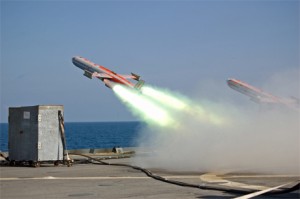
An MQM-74C aerial target drone launches from the deck of the dock landing ship USS Tortuga for a scheduled missile exercise. Photo: U.S. Navy photo by Cmdr. James Ridgeway/Released
Cross-posted from Joshua Foust’s column for PBS’ Need To Know.
Drones are a hot topic in U.S. defense circles these days. The Obama administration has increased their use in lethal strikes against suspected terrorists several fold since taking office in 2009. Analysts have taken to crediting drones, and not the wars in Afghanistan and Iraq, as the cause of al Qaeda in Pakistan’s demise.
We don’t really know what effects drones have. Press reports are notoriously unreliable indicators of the actual number of casualties from drone strikes and it’s difficult to say exactly who is killed in these strikes. Most fatalities are never positively identified.
In Pakistan, explains C. Christine Fair, assistant professor at Georgetown, reliable data about victims just doesn’t exist, “There is a problem of circular reportage,” she said at a panel convened at my think tank, the American Security Project. News sources reporting on drone victims ultimately end up citing the Pakistani or U.S. governments, neither of which is necessarily credible in discussing the drone campaign.
Complicating matters, Dr. Fair noted, is that it’s not always certain that explosions and casualties result from a drone strike. “Drones [in Pakistan] are collocated with terrorist incidents,” she said. “It means that some of those children injured and killed may have been the victims of terrorist attacks or even Pakistani military attacks.” Additionally, she said, the lack of forensic experts makes assigning blame for the violence in Northwest Pakistan extremely difficult, if not impossible.
According to Dr. Fair, the biggest challenge in counting the costs from drone strikes is Pakistan itself. “If the Pakistani government were sincere in its howling about drones… they would have UNAMA set up a CIVCAS unit nearby,” referring to the United Nations Assistance Mission to Afghanistan’s Civilian Casualties investigative program. She also suggested that fact-finding would improve if the Pakistani government began allowing journalists to visit the drone-affected regions.
Drones have also been used to conduct strikes in Yemen and Somalia where it is equally difficult to determine exact outcomes. In Yemen, it is incredibly difficult to get to the site of the strike – and even then, foreign researchers have a difficult time determining when to trust interview subjects. This is why one researcher may maintain drones are popular while another notes that they breed widespread anger and recruit for terrorist groups.
If we can’t determine collateral damage from drones, can we tell how they’re affecting the terror groups they target? Speaking at the aforementioned panel, Aaron Zelin, from the Washington Institute for Near East Policy, said drones have substantially affected the ability of terror groups to train.
In order to avoid surveillance, terrorist groups have developed “mobile training camps” in Yemen. ‘Mobile’ because terror organizations will now drive out into a desert area, practice some exercises and firing weapons, and then drive back into the towns they inhabit. This is because, Zelin said, they’ve noticed that the U.S. will fire a missile into a random patch of desert but will hesitate to attack a populated area.
Will McCants, an analyst with the CNA think tank, says that there’s been very little “blowback” we can directly tie to lethal drone strikes. While some new people might join terror groups in response to drone strikes, he noted, it is only Faisal Shahzad, the incompetent Times Square bomber, who has said he took up arms as a result.
Rather, Dr. McCants argues, drones have forced terror groups to change their tactics and set up “counterspy networks” where they try to locate and kill insiders who feed information to US intelligence.
Absence of data is also a problem on the U.S. side. Part of the drones program remains so heavily restricted by the U.S. government, there is no confirmation the program even exists. The targeting mechanisms for drones strikes is highly classified – so understanding how this type of information is collected, cross-checked, and analyzed would reveal methodologies and sources the government does not want to divulge.
With bad or missing data and uncooperative governments, can we really discuss the real costs – or benefits– of the drones program? From the bits of data we do have available, drones are actually lower-casualty alternatives to countering terrorism; as traditional Pakistani military offensives have killed countless civilians and displaced hundreds of thousands.
Beyond these very imprecise measurements about the human cost, it is impossible to know the effectiveness of drones. The strikes kill both terrorists, and civilians – but we don’t know to what extent. Without more transparency about the government sanctioned use of drones, or even more oversight from Congress, we won’t be able to quantify the costs of these types of attacks… and the program will continue on in shadows.


